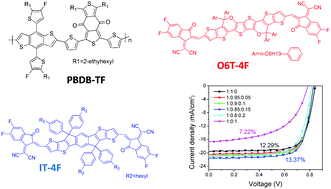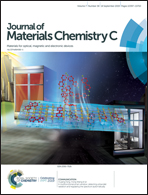High-efficiency ternary nonfullerene organic solar cells fabricated with a near infrared acceptor enhancing exciton utilization and extending absorption†
Abstract
The ternary blend strategy has the potential to enhance spectral coverage and boost the power conversion efficiency (PCE) of organic solar cells (OSCs). Besides the consideration of complementary absorption to broaden the solar spectral coverage with a combination of multiple photoactive materials, a third component plays a vital role in morphological evolution and photophysical processes in the blend films which dominates the final photovoltaic performance of the devices. Herein, we fabricated a kind of ternary OSC that consists of one donor polymer PBDB-TF and two non-fullerene molecular acceptors IT-4F and O6T-4F. With elaborate optimization of the IT-4F : O6T-4F ratio, the ternary OSCs achieve a VOC of 0.83 V, a JSC of 21.60 mA cm−2 and an FF of 0.746, leading to an overall PCE of 13.37%. Compared to the control OSCs based on the binary PBDB-TF:IT-4F blend, the JSC and PCE of the ternary devices are increased by 10.5% and 8.8%, respectively. A detailed study discloses that incorporation of a small amount of low-bandgap O6T-4F into the PBDB-TF:IT-4F blend not only favors the optimization of the interpenetrating donor/acceptor morphology, but also improves the exciton utilization via energy transfer from IT-4F to O6T-4F and extends the spectral coverage. Moreover, such a kind of ternary OSC shows excellent independence of active layer thicknesses with PCEs up to 12% when the active layer thickness is increased to 300 nm.

- This article is part of the themed collection: Editor’s Choice: Organic Photovoltaics


 Please wait while we load your content...
Please wait while we load your content...